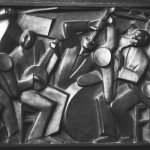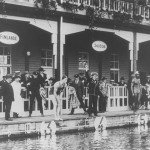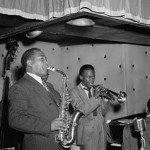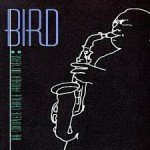Improvisation in jazz
Hello Dear Reader,
Gosh it is warm in Switzerland today! The spring burst of colour that began last week is now in full flow thanks to a day or so of heavy rain. Glowing primroses, cheeky crocuses and alpine daisies swing gracefully in the herb scented winds that come down from the mountains.
This has to be my favourite season. All the promise of life is new.
 While nature is in full-on improvisation mode, it seems only right that we consider a new paper in the journal Music Perception on improvisation in jazz. The Hochschule where I work in Switzerland also has jazz specialism, and a special research project on the sensation of groove.
While nature is in full-on improvisation mode, it seems only right that we consider a new paper in the journal Music Perception on improvisation in jazz. The Hochschule where I work in Switzerland also has jazz specialism, and a special research project on the sensation of groove.
Today our blog is therefore inspired by both my surrounding nature and my nurture! I dedicate it to Olivier Senn.
The new article to which I refer is by Martin Norgaard at the Georgia State University (US). Martin (I hope he does not mind me calling him that) has conducted an analysis of 48 improvised solos by the great Charlie Parker in order to test two competing theories:
1) Entire motor patterns for improvisation are stored in long-term procedural memory and are inserted into ongoing improvisation as and when appropriate (pattern use)
2) Improvised output is based on procedures based on the rules of jazz, but does not comprise fixed memories. These patterns are in a sense much more ‘accidental’ (procedures)
A quick intro to Charlie “Bird” Parker for those who may not be familiar:

Charlie was born in 1920 in Kansas, USA. He had his first alto saxophone lessons in school during the early 1930s and left school in 1935 with the intention of being a full-time professional musician. He worked mainly in Kansas City and played with numerous local blues and jazz groups.
His learning process has been described as ‘trial and error’ as he learned his craft while touring and competing as a musician and during jam sessions with various artists. His name first starts to appear in the music press in the early 1940s.
By the middle of the 1940s Charlie was well known and respected for his distinctive and extraodinary improvisations.
 He worked between New York and LA in the mid to late 1940s, with greats such as John Birks “Dizzy” Gillespie. His career began to suffer after 1946 due to a nervous breakdown, heroin and alcohol addictions. Despite this, he returned to New York in 1947 to record some of his best work with Miles Davis, Duke Jordan, Tommy Potter, and Max Roach. Check out this recording of ‘A Night in Tunisia’ recorded with Miles Davis. Charlie also visited Europe from 1949 to 1950 and made many successful recordings that still survive.
He worked between New York and LA in the mid to late 1940s, with greats such as John Birks “Dizzy” Gillespie. His career began to suffer after 1946 due to a nervous breakdown, heroin and alcohol addictions. Despite this, he returned to New York in 1947 to record some of his best work with Miles Davis, Duke Jordan, Tommy Potter, and Max Roach. Check out this recording of ‘A Night in Tunisia’ recorded with Miles Davis. Charlie also visited Europe from 1949 to 1950 and made many successful recordings that still survive.
Charlie’s final engagements back in the US in the 1950s were sporadic and plagued by poor physical and mental health. He died in New York in 1955 of a heart attack, brought on by advanced cirrhosis.
 As a master of improvisation, Charlie’s ability can be compared to other forms of spontaneous creativity within a framework of established rules and/or structure. To return to our paper, Martin compares improvisation to that of a basketball player bypassing defence or a presenter working without a teleprompter. Their output has certain rules in order to be considered legal and/or understood but they seamlessly create new formulations of their skill in real time.
As a master of improvisation, Charlie’s ability can be compared to other forms of spontaneous creativity within a framework of established rules and/or structure. To return to our paper, Martin compares improvisation to that of a basketball player bypassing defence or a presenter working without a teleprompter. Their output has certain rules in order to be considered legal and/or understood but they seamlessly create new formulations of their skill in real time.
Are they simply inserting pre-learned structures (pattern use), motor schemata from their memory or do these patters occur by chance as the improviser uses learned procedures that follow the rules (be they rules from jazz, basketball or grammar)?
 The most logical solution is to say, a bit of both – probably – at different times. Martin’s previous studies support this idea, thanks to interviews with performers. I like the comparison as one of building with lego or weaving in changes. Studies show that when building blocks are not available, if forced to improvise in an unfamiliar key, then performers don’t have access to stored motor programs (Goldman, 2012). But what if they are in their element?
The most logical solution is to say, a bit of both – probably – at different times. Martin’s previous studies support this idea, thanks to interviews with performers. I like the comparison as one of building with lego or weaving in changes. Studies show that when building blocks are not available, if forced to improvise in an unfamiliar key, then performers don’t have access to stored motor programs (Goldman, 2012). But what if they are in their element?
This is where Charlie Parker comes in. Martin studied 48 of his short improvisations dating from 1946 to 1954. The one notated example given in the paper is 22 notes long. The corpus was transcribed in the late 1980s by Peter Sprague.
The MIDI files of the recordings were imported into Finale for editing and then into MATLAB where the data were converted into information about beat onset and duration, channel, pitch, velocity, onset and duration. The aim was to extract the pitch and rhythm patterns, to see if similar patterns ocurred with regularity or if their appearance could be ascribed to chance.
The ultimate question is does Parker have a ‘…memorized library of melodic figures that is accessed during all improvisations?’ (p.272)
RESULTS: In total, 82.6% of the eligible notes in the corpus began a 4-interval (5 note) pattern and the mean number of times these patterns were repeated in the corpus was 26.3. Astonishingly, half the notes in the corpus started a 4-interval pattern that ocurred 9 times or more. Even when the analysis was limited to sequences containing the same four intervals and rhythms, 57.6% of notes started patterns that ocurred at least twice in the corpus.
The whole analysis of this paper is very comprehensive and goes into pattern lengths and the composition of common patterns, but I won’t go into the detail of that here.
 This analysis doesn’t take account of patterns repeated with slight variations, and many would argue that the devil, in this case the delight, is in the detail. No-one (no-one I know) would question Charlie Parker’s creativity – that is not the point of the analysis. The point is to show that even the best improvisers rely on patterns, brought forth auditory and motor programs from memory, and skilfully insert them at the right points in performance.
This analysis doesn’t take account of patterns repeated with slight variations, and many would argue that the devil, in this case the delight, is in the detail. No-one (no-one I know) would question Charlie Parker’s creativity – that is not the point of the analysis. The point is to show that even the best improvisers rely on patterns, brought forth auditory and motor programs from memory, and skilfully insert them at the right points in performance.
In summary, the answer to our question – does Parker have a memorized library of melodic figures that is accessed during all improvisations – is almost certainly ‘yes’. In total, Martin suggests that 99.3% of the notes in the corpus he studied were part of a pattern.
It seems therefore, that pattern use is essential to improvisation. The idea that such patterns are not stored and re-used (the other theory we called procedures) is hard to reconcile with these data.
But remember we are talking here about improvisation in the most comfortable setting, where the performer knows the rules and structure of the sound around him like the back of his hand. What happens when improvisers are placed outside their comfort zone is an interesting question for future research. In such an arena it is likely that our two theories will not come to the same conclusion.
 So, Dear Reader, I wish you a happy weekend. I hope the weather is lovely – and if not, have no fear. Summer is around the corner…or if you love Charlie Parker, then it is just a click away.
So, Dear Reader, I wish you a happy weekend. I hope the weather is lovely – and if not, have no fear. Summer is around the corner…or if you love Charlie Parker, then it is just a click away.
“Music is your own experience, your own thoughts, your wisdom. If you don’t live it, it won’t come out of your horn. They teach you there’s a boundary line to music. But, man, there’s no boundary line to art” – Charlie Parker
Reference: Norgaard, M. (2014) How jazz musicians improvise: The central role of auditory and motor patterns. Music Perception, 31 (3), 271-287.
2 Comments
Pingback:
Pingback: